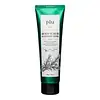What's inside
What's inside
 Key Ingredients
Key Ingredients

 Benefits
Benefits

 Concerns
Concerns

 Ingredients Side-by-side
Ingredients Side-by-side

Water
Skin ConditioningPumice
AbrasiveGlycolic Acid
BufferingStearic Acid
CleansingCetearyl Alcohol
EmollientCI 77891
Cosmetic ColorantSodium Hydroxide
BufferingJojoba Esters
EmollientGluconolactone
Skin ConditioningGlycerin
HumectantSodium Cocoyl Isethionate
CleansingDimethicone
EmollientSalicylic Acid
MaskingSimmondsia Chinensis Seed Oil
EmollientSqualane
EmollientSodium Hyaluronate
HumectantLeuconostoc/Radish Root Ferment Filtrate
AntimicrobialBisabolol
MaskingC12-15 Alkyl Benzoate
AntimicrobialHippophae Rhamnoides Fruit/Seed Oil
AntimicrobialNiacinamide
SmoothingRosa Canina Fruit Oil
EmollientCamellia Sinensis Leaf Extract
AntimicrobialGlycyrrhiza Glabra Root Extract
BleachingGlycine Soja Oil
EmollientSteareth-20
CleansingXanthan Gum
EmulsifyingSteareth-21
CleansingPhenoxyethanol
PreservativeEthylhexylglycerin
Skin ConditioningTetrasodium Glutamate Diacetate
Tocopherol
AntioxidantWater, Pumice, Glycolic Acid, Stearic Acid, Cetearyl Alcohol, CI 77891, Sodium Hydroxide, Jojoba Esters, Gluconolactone, Glycerin, Sodium Cocoyl Isethionate, Dimethicone, Salicylic Acid, Simmondsia Chinensis Seed Oil, Squalane, Sodium Hyaluronate, Leuconostoc/Radish Root Ferment Filtrate, Bisabolol, C12-15 Alkyl Benzoate, Hippophae Rhamnoides Fruit/Seed Oil, Niacinamide, Rosa Canina Fruit Oil, Camellia Sinensis Leaf Extract, Glycyrrhiza Glabra Root Extract, Glycine Soja Oil, Steareth-20, Xanthan Gum, Steareth-21, Phenoxyethanol, Ethylhexylglycerin, Tetrasodium Glutamate Diacetate, Tocopherol
Disodium Laureth Sulfosuccinate
CleansingJuglans Regia Shell Powder
AbrasiveCocamidopropyl Betaine
CleansingCocamide DEA
EmulsifyingGlycerin
HumectantSodium Chloride
MaskingPunica Granatum Fruit Extract
AntioxidantHoney Extract
HumectantRosa Hybrid Flower Extract
Skin ConditioningPrunus Serrulata Flower Extract
Skin ConditioningChrysanthemum Morifolium Flower Extract
Skin ConditioningCocamide Methyl Mea
Parfum
MaskingTriethanolamine
BufferingLaureth-9
EmulsifyingRosmarinus Officinalis Extract
AntimicrobialChamomilla Recutita Flower/Leaf Extract
AntimicrobialLavandula Angustifolia Extract
Skin ConditioningCentella Asiatica Extract
CleansingMonarda Didyma Leaf Extract
Skin ConditioningCarbomer
Emulsion StabilisingSodium Hyaluronate
HumectantDisodium Lauroyl Glutamate
CleansingAscorbic Acid
AntioxidantPolyquaternium-10
Phenoxyethanol
PreservativeDisodium EDTA
Ethylhexylglycerin
Skin ConditioningDisodium Laureth Sulfosuccinate, Juglans Regia Shell Powder, Cocamidopropyl Betaine, Cocamide DEA, Glycerin, Sodium Chloride, Punica Granatum Fruit Extract, Honey Extract, Rosa Hybrid Flower Extract, Prunus Serrulata Flower Extract, Chrysanthemum Morifolium Flower Extract, Cocamide Methyl Mea, Parfum, Triethanolamine, Laureth-9, Rosmarinus Officinalis Extract, Chamomilla Recutita Flower/Leaf Extract, Lavandula Angustifolia Extract, Centella Asiatica Extract, Monarda Didyma Leaf Extract, Carbomer, Sodium Hyaluronate, Disodium Lauroyl Glutamate, Ascorbic Acid, Polyquaternium-10, Phenoxyethanol, Disodium EDTA, Ethylhexylglycerin
 Reviews
Reviews

Alternatives
Ingredients Explained
These ingredients are found in both products.
Ingredients higher up in an ingredient list are typically present in a larger amount.
Ethylhexylglycerin (we can't pronounce this either) is commonly used as a preservative and skin softener. It is derived from glyceryl.
You might see Ethylhexylglycerin often paired with other preservatives such as phenoxyethanol. Ethylhexylglycerin has been found to increase the effectiveness of these other preservatives.
Glycerin is already naturally found in your skin. It helps moisturize and protect your skin.
A study from 2016 found glycerin to be more effective as a humectant than AHAs and hyaluronic acid.
As a humectant, it helps the skin stay hydrated by pulling moisture to your skin. The low molecular weight of glycerin allows it to pull moisture into the deeper layers of your skin.
Hydrated skin improves your skin barrier; Your skin barrier helps protect against irritants and bacteria.
Glycerin has also been found to have antimicrobial and antiviral properties. Due to these properties, glycerin is often used in wound and burn treatments.
In cosmetics, glycerin is usually derived from plants such as soybean or palm. However, it can also be sourced from animals, such as tallow or animal fat.
This ingredient is organic, colorless, odorless, and non-toxic.
Glycerin is the name for this ingredient in American English. British English uses Glycerol/Glycerine.
Learn more about GlycerinPhenoxyethanol is a preservative that has germicide, antimicrobial, and aromatic properties. Studies show that phenoxyethanol can prevent microbial growth. By itself, it has a scent that is similar to that of a rose.
It's often used in formulations along with Caprylyl Glycol to preserve the shelf life of products.
Sodium Hyaluronate is hyaluronic acid's salt form. It is commonly derived from the sodium salt of hyaluronic acid.
Like hyaluronic acid, it is great at holding water and acts as a humectant. This makes it a great skin hydrating ingredient.
Sodium Hyaluronate is naturally occurring in our bodies and is mostly found in eye fluid and joints.
These are some other common types of Hyaluronic Acid:
Learn more about Sodium Hyaluronate